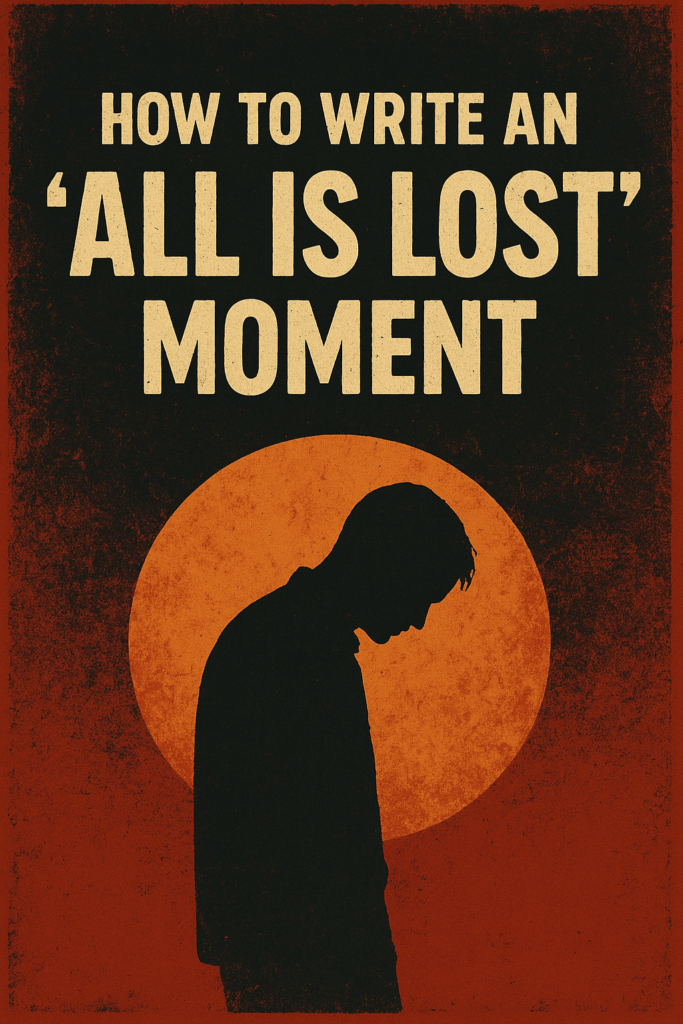Five Examples of the All is Lost for Screenwriters

The protagonist’s progress is destroyed in one key moment.
Her goal lies in shambles; the path forward now seems impossible.
In Blake Snyder terms, this is known as the All is Lost moment.
This doesn’t necessarily mean literal death, although sometimes there is an actual death (think Obi-Wan getting cut down by Darth Vader).
Most of the time, however, it is a metaphorical death: it is the crumbling of a dream, the loss of allies, failure of a plan, or a deep betrayal.
Sometimes, as we will see, it is all of these things.
Definition of the All is Lost Moment
Blake Snyder defines it as the point (often around 75% of the way through the story) where it seems like all hope is gone.
The protagonist’s plan has failed.
Her allies have fled or disowned her (or both).
She is as alone as the story can allow her to be.
Her world is collapsing. We, as the audience, seriously wonder whether she’ll throw in the towel.
Everything she fought for is ruined.
Snyder notes that this is often accompanied by a “whiff of death,” but don’t get too heavy-handed here. It’s usually symbolic.
That is:
- Her boyfriend tells her she’s nuts and walks out
- The mentor kills himself
- The villain reveals he’s actually the father
- She realizes she’s actually as vile as the girl she claims to hate
- Blowing up the ship becomes the only feasible option
Sometimes the examples are actually fairly one-plotline straightforward. Other times, intersecting A, B, and C stories all collide at once. We’ll look at three simple and two layered examples.
Simple All is Lost Examples
1. Back to the Future (1985)
George stands up to Biff and saves Lorraine, but Marty is still fading from existence. George and Lorraine haven’t fallen in love yet. Marty will vanish from existence unless he plays guitar (with a vanishing hand, no less) to make that happen.
It is the same crisis, but it piggybacks: George steps up, but Marty’s own life is still in danger. The audience sees George’s win immediately countered by Marty’s impending erasure.
2. Raiders of the Lost Ark (1981)
Indy, Marion, and their Ark Baby are finally safe aboard the tramp steamer. Then they wake to find the steamer captured by a Nazi submarine. The Ark is seized and Marion is, of course, taken hostage again.
One step forward, ten steps back. Indy and Marion had the treasure. They escaped. Now it’s gone. And it’s the middle of the ocean.
Indy’s going to have to do something absurd–like hold to that periscope and hope for the best–if he hopes to save the day.
3. The Apartment (1960)
Baxter alienates both his superiors and his neighbors in the process of saving Fran’s life. For all his trouble, Fran’s brother-in-law punches him in the face.
Baxter’s kindness toward Fran has risked his job, ruined his reputation with his neighbors, and destroyed the prospect of making nice with her family. Not to put too fine a point on it, but he is literally (not figuratively) punched in the face for doing the right thing.
Layered All is Lost Examples
4. Ghostbusters (1984)
Just when the Boys are finally being taken seriously, Peck shows up and shuts off the Containment Unit. Dana is sleeping three feet above her bed. Chaos erupts across New York as the captured ghosts are released. The Keymaster gets loose and (ahem) slips his key into the Gatekeeper, summoning Gozer.
This moment operates on multiple levels:
- Institutional failure: Peck, not realizing what he’s doing, releases the ghosts.
- Mythical stakes: aw shit, now we have to deal with a resurgent Sumerian demon.
- Personal stakes: Zuul has possessed Venkman’s love interest.
Everything converges here: the Boys have failed at their explicit task, and New York is probably doomed.
5. Blue Velvet (1986)
Jeffrey learns that the Yellow Man is a corrupt police officer. He and Sandy have just confessed their love to each other, only to have Mike show up and confront them. At this moment, Dorothy stumbles out of the bushes, naked and battered. Dorothy proceeds to reveal her affair with Jeffrey to Sandy.
This moment is layered emotionally, morally, and narratively:
- The protagonist’s naive conceptions of “good” and “evil” are shattered
- The B-story romance with Sandy is torched
- Jeffrey’s affair–now out in the open–links Mike, Sandy, the Yellow Man, Sandy’s father, and Frank.
Jeffrey is now forced to confront the costs of his perverse curiosity.
Essential Elements of the All is Lost
Any good All is Lost features at least one of these items, if not more.
1. Reversal of Fortune
Everything the protagonist gained is taken away—or proves to be meaningless.
2. The Whiff of Death
Someone or something dies. Literally or metaphorically. But it needs to make sense! Don’t just arbitrarily kill a puppy here (or John Wick will be very angry).
3. Isolation
The protagonist is alone. There might be people around physically, but she feels abandoned. A love interest leaves. A mentor disappears. The team splits up.
4. The “Bond Villain Speech”
The villain gloats, or reveals a devastating truth. Think:
- Kanye tweetstorms
- The villain reveals that whole adventure thus far has been a trap
- The overblown justification, complete with a laser creeping toward James Bond’s nuts
5. Narrative Implosion
If you have multiple plot threads, this is where they all crash–usually together. Everything that could go wrong does; it may now be related in a way it never was before.
If you only have one storyline, make sure the core dream collapses entirely.
Common Pitfalls in the All is Lost Section
Underplaying the Stakes
You have to make us think: “This might actually be the end.” If shit doesn’t get absolutely dire here, forget it.
Skipping Emotional Fallout
The emotional weight of what’s just happened needs to be clear to the audience. After the All is Lost often comes the Dark Night of the Soul. Plan for this moment of silence, rage, tears, or what have you.
Convenience Over Conflict
This should be the result of the protagonist’s choices. That’s what escalates the narrative. It is not about the mentor getting run over by a bus.
Exercises
Exercise 1: Name the Unrecoverable
Ask yourself what the one thing is your protagonist could lose and never get back.
- In Blue Velvet, Jeffrey loses his innocence, and presumably Sandy’s trust
- In The Apartment, Baxter risks his job, destroys his social standing, alienates Fran’s family, and feels slimy for letting Sheldrake bully him into covering up
Write a short scenario where this terrible thing happens: the death of a person, a relationship, or the protagonist’s faith in herself.
Then–ask what could make it even worse.
Exercise 2: Weave the Threads
If your story has multiple subplots (romantic, professional, moral, etc.), create a list:
- The protagonist’s external goal
- The protagonist’s internal goal
- The love interest
- The mentor or guide
- The main antagonist
- A moral question or theme
Of course your film might not have all of these, but list whatever is there. Consider how all of this can collapse in 5-8 minutes of screen time.
Knock everything down; aim for maximum emotional disorientation among the audience.
Exercise 3: The Whiff of Death
For your script, fill in the following blanks:
- Literal death (if any): ___________
- Symbolic death: ___________
- What has been erased or invalidated: ___________
- Who abandons or betrays the protagonist: ___________
- What is the darkest thought your protagonist has at this point? ___________
If you can answer these questions, this means that the All is Lost will be based on emotion rather than simply plot.
The Meaning of the All is Lost
Remember, if the audience doesn’t feel that everything is lost, they won’t care when the protagonist finds the strength to rise again.
So be bold. The protagonist must fall farther than you think she’ll be able to recover from.
The contrast between this and success in the Third Act is the key to triumph. It demonstrates grit and resilience, not cheap plot tricks.
Remember, the deeper the fall, the more meteoric the rise.

